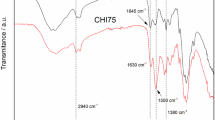Abstract
Poly(ethylene glycol)/chitosan (PEG/CH) hydrogel and its composite containing carbon nanotubes (PEG/CH/CNTs) were prepared using a simple blending method. The effect of the PEG/CH ratio on the water uptake was studied and optimized. And the prepared hydrogels were characterized by XRD, SEM, and FTIR. Also, the ability of each of the prepared hydrogels to adsorb and separate maltene fractions was compared using saturates, aromatics, resins, and asphaltenes (SARA) method. From the results, it was noticed that the adsorption capacity and separation ability of PEG/CH/CNT are better than that of PEG/CH. But the released amount of alkane fractions using these hydrogels is higher than that in the reference (without using hydrogel). This may be attributed to degradation of maltene residue to alkanes and that degradation is better by using PEG/CH adsorbent than PEG/CH/CNT. Although, from a practical point of view, where PEG/CH/CNT hydrogel may be favorable, it has an acceptable ability to adsorb and separate the maltene fractions.








Similar content being viewed by others
References
Abdeen Z (2005) Preparations and applications of some friendly environmental compounds, Ph.D. Thesis, Ain-Shams University, Cairo
Abdeen Z (2011) Swelling and reswelling characteristics of cross-linked poly(vinyl alcohol)/ chitosan hydrogel film. J Dispers Sci Technol 32:1337–1344
Akmaz S, Iscan O, Gurkaynak MA, Yasar M (2011) The structural characterization of saturate, aromatic, resin, and asphaltene fractions of Batı Raman crude oil. Pet Sci Technol 29:160–171
AL-Sabagh AM, Abdeen Z (2010) Preparation and characterization of hydrogel based on poly vinyl alcohol crosslinked by different crosslinker used to dry organic solvents. J Polym Environ 18:576–583
Bulut Y, Akçay G, Elma D, Serhatl IE (2009) Synthesis of clay-based superabsorbent composite and its sorption capability. J Hazard Mater 171:717–723
Chandra MS, Norhusna MN (2012) Relationship between SARA fractions and crude oil fouling. J Appl Sci 12:2479–2483
Duarte-Delgado D, Narváez-Cuenca CE, Restrepo-Sánchez LP, Kushalappa A, Mosquera-Vásquez T (2015) Development and validation of a liquid chromatographic method to quantify sucrose, glucose, and fructose in tubers of Solanum tuberosum group Phureja. J Chromatogr B 975(15):18–23
Elham K, Somayeh S, Mahmoud M (2013) Determination of saturates, aromatics, resins and asphaltenes (SARA) fractions in Iran crude oil sample with chromatography methods: study of the geochemical parameters. J Appl Chem Res 7(4):15–24
Ferreira VF, Da Rocha DR, Da Silva FC (2009) Potentiality and opportunity in the chemistry of sucrose and other sugars. Quim Nov. 32:623
Henryk S, Olli K (1990) Microcrystalline chitosan some areas of application. Br Polym J 23:261–265
Hiromitsu K, Veronica I, Lester Y, Reginald G, Helen W (2005) Importance of debye and keesom interactions in separating m-Xylene and p-Xylene in GC-MS analysis utilizing PEG stationary phase. J Chromatogr Sci 43(2):57–62
Hortal AR, Hurtado P, Martínez-Haya B, Mullins OC (2007) Molecular-weight distributions of coal and petroleum asphaltenes from laser desorption/ionization experiments. Energy Fuel 21(5):2863–2868
Jing F, Meiling Q, Ruonong F, Liangti Q (2015) Performance of graphene sheets as stationary phase for capillary gas chromatographic separations. J Chromatogr A 1399(19):74–79
Kaşgöz H, Durmuş A, Kaşgöz A (2008) Enhanced swelling and adsorption properties of AAm-AMPSNa/clay hydrogel nanocomposites for heavy metal ion removal. Polym Adv Technol 19:213–220
Lee WF, Huang CT (2008) Immobilization of trypsin by thermo-responsive hydrogel for the affinity separation of trypsin inhibitor. Desalination 234:195–203
Liao MH, Chen DH (2002) Preparation and characterization of a novel magnetic nano-adsorbent. J Mater Chem 12:3654–3659
Matthew SP, Keith LG, Chad BT, Peter KK (2003) Effects of petroleum resins on asphaltene aggregation and water-in-oil emulsion formation. Colloids Surf A Physicoch Eng Asp 220:9–27
Seung JL, Seong SK, Young ML (2000) Interpenetrating polymer network hydrogels based on poly(ethylene glycol) macromer and chitosan. Carbohydr Polym 41:197–205
Spitalsky Z, Tasis D, Papagelis K, Galiotis C (2010) Carbon nanotube–polymer composites: chemistry, processing, mechanical and electrical properties. Prog Polym Sci 35:357–401
Srivastava S (2013) Sorption of divalent metal ions from aqueous solution by oxidized carbon nanotubes and nanocages: a review. Adv Mater Lett 4:2–8
Vazquez D, Mansoori GA (2000) Identification and measurement of petroleum precipitates. J Pet Sci Eng 26:49–56
Yang ST, Guo W, Lin Y, Deng XY, Wang HF, Sun HF, Liu YF, Wang X, Wang W, Chen M, Huang YP, Sun YP (2007) Biodistribution of pristine single-walled carbon nanotubes in vivo. J Phys Chem C 111:17761–17764
Zheng Y, Wang A (2010) Enhanced adsorption of ammonium using hydrogel composites based on chitosan and halloysite. J Macromol Sci A 47:33–38
Zheng Y, Li P, Zhang J, Wang A (2007) Study on superabsorbent composite XVI. Synthesis, characterization and swelling behaviors of poly(sodium acrylate)/ vermiculite superabsorbent composites. Eur Polym J 43:1691–1698
Acknowledgments
We are grateful for the members in the Petrochemicals Department, Egyptian Petroleum Research Institute (EPRI) for valuable support.
Author information
Authors and Affiliations
Corresponding author
Additional information
Responsible editor: Philippe Garrigues
Rights and permissions
About this article
Cite this article
Abdeen, Z. Adsorption efficiency of poly(ethylene glycol)/chitosan/CNT blends for maltene fraction separation. Environ Sci Pollut Res 23, 11240–11246 (2016). https://doi.org/10.1007/s11356-016-6225-0
Received:
Accepted:
Published:
Issue Date:
DOI: https://doi.org/10.1007/s11356-016-6225-0




